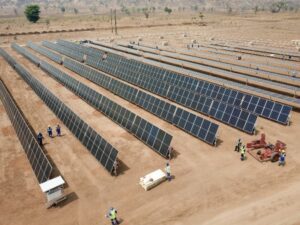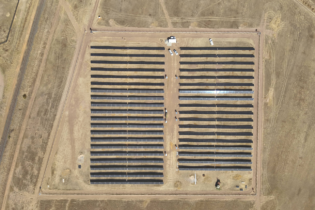Operational from Q1 2022, the 20 MW AC Golomoti Solar PV and Battery Energy Storage project is a groundbreaking development that delivers a green power solution for Malawi.
Co-developed by JCM Power, a Canadian independent power producer, and InfraCo Africa, an investment company of the Private Infrastructure Development Group, the project is believed to be the first utility-scale, grid-connected, hybrid solar and battery energy storage system (BESS) in sub-Saharan Africa. The project’s success has been made possible due to several partners, including USAID, which provided critical development funding, Innovate UK’s Energy Catalyst programme, which provided grant funding for the batteries, and IFU, which provided JCM with debt funding. Located in Dedza, some 100 km south-east of the country’s capital, Lilongwe, the power facility was built at a cost of around R465 million (inclusive of professional fees and construction costs). This major investment in one of the world’s poorest countries is especially significant given the fact that only about 10% of Malawi’s population has access to electricity. Malawi currently relies heavily on hydropower, exposing the country to energy security risks during the dry season, as well as extended droughts, making renewable alternatives a highly viable approach. Zutari was appointed as the engineer for the project. The scope encompassed site identification, concept development, tender development/procurement, preliminary design, and detail design through to project execution. More specific elements comprised the PV plant design and layout, civil works, geotechnical investigation and foundation design, and electrical works. Much of the design and finer details of the project were discussed and resolved online during the learning curve of the 2020 Covid-19 lockdown. Surrounding villages and a baobab tree The site location presented several complexities. These included: difficult ground conditions that changed with the seasons; a landlocked country, where the procurement of equipment would be expensive and logistically demanding; a complicated site shape, housing a magnificent baobab tree that needed to be preserved; and encroaching village settlements. Embracing these challenges, the villages and the baobab subsequently became an integral part of the virtual design, which was developed using Zutari’s in-house computational design tool, 7SecondSolar. Thanks to this advanced software platform, it was possible to do multiple design iterations in hours instead of weeks. This enabled Zutari to assist the client with comprehensive design optimisations that provided greater certainty regarding capital expenditure right from the start of the project. That proved highly beneficial, given the constant global fluctuation in PV costs. Virtual design optimisation continued throughout the development process. Examples include the evaluation of potential PV panel shading by having the panels track the sun’s position. The model also assessed the impact of the baobab tree on potential shading in optimising the final PV layout. In the final design, the BESS modules and the tree form the centre around which the surrounding solar array was constructed. Leading substation design The Golomoti PV project also used Zutari’s innovative 3D substation design, a field in which the company is a market leader. The 3D design allows a single model to be produced that embodies all the equipment and layout details – available at the click of a button.Advanced features allow the lightning protection to be viewed in a 3D space to ensure the protection covers all equipment. This 3D facility also increases accuracy and gives design refinement for manufacturing, ensuring all parts fit together, while drawings and BoQs can be generated efficiently, quickly and accurately.
Furthermore, civil designs were optimised to reduce costs by designing earthworks and drainage using locally available materials. It was determined that drainage on the site could significantly impact the villages, especially during tropical storm rainfall events. As a proactive measure, the final design catered for this, ensuring water flow is limited and contained to a safe point.










